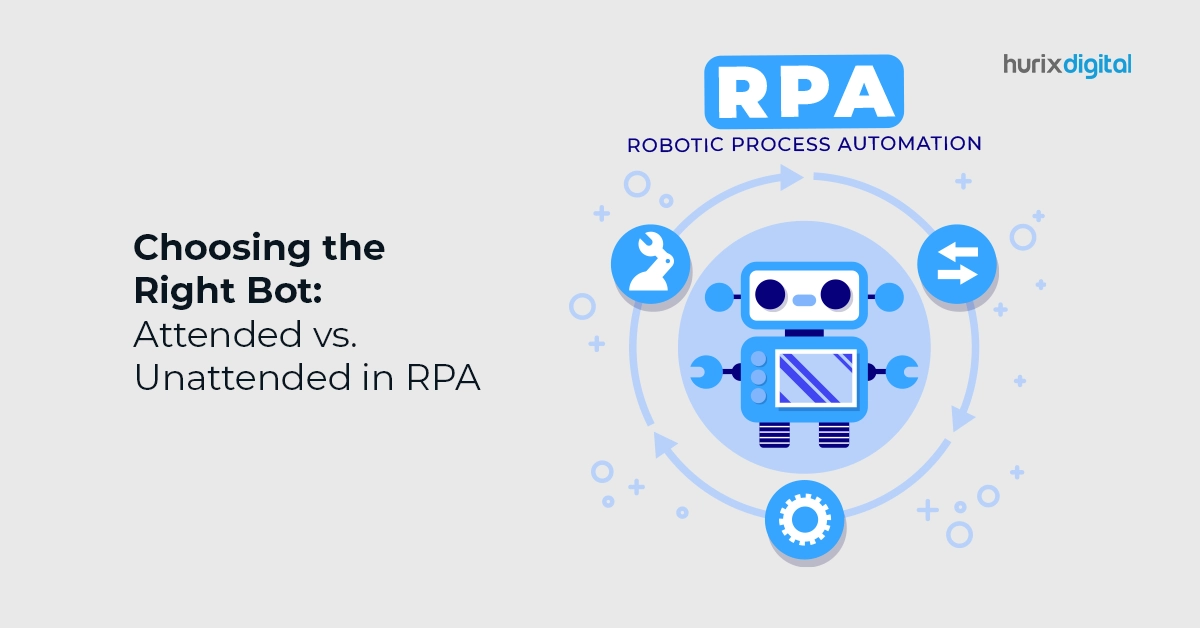Choosing the Right Bot: Attended vs. Unattended in RPA
Robotic process automation (RPA) has changed the way companies handle repetitive tasks and freeing resources to focus on more complex activities. RPA uses automation technology to perform human tasks. Within the RPA landscape, there are two key types of RPA bots: attended RPA bots and unattended RPA bots.
Understanding the differences between these bot types and knowing when to use each can significantly enhance the efficiency and effectiveness of your automation initiatives. After RPA implementation, companies met with a satisfactory investment return. The RPA enables organizations to harness the power of intelligent automation, enabling them to handle complex, data-driven processes.
In this blog post, we will delve into the characteristics, use cases, and benefits of attended and unattended bots, providing you with the insights you need to make informed decisions.
Table of Contents:
- Attended Bots
- Use Cases for Attended Bots
- What are the Five Benefits of Attended Bots?
- Unattended Bots
- Use Cases for Unattended Bots
- What are the Seven Benefits of Unattended Bots?
- Conclusion
Attended vs Unattended RPA: Comparing Benefits and Use Cases
Attended Bots
Attended bots, as the name suggests, work alongside human operators. These bots are designed to assist users in their daily tasks by providing real-time guidance, automating specific steps, or fetching information from various systems.
Attended bots typically require user intervention or collaboration to execute tasks, making them ideal for processes that involve complex decision-making, exception handling, or human interaction. Attended automation bots should be agile and user-friendly for humans collaborating with these as very often humans may have to move between multiple screens or interfaces and platforms to complete the task.
Use Cases for Attended Bots
Attended bots act as virtual assistants to humans and are best suited to augment tasks that still need manual efforts for completion like:
- Customer Service: Attended bots can support customer service agents by fetching relevant customer information, suggesting responses, or automating routine tasks like data entry. This allows agents to focus on providing personalized and efficient service.
- Data Analysis: Attended bots can assist analysts by automating data gathering, cleansing, and basic analysis tasks, enabling them to spend more time on in-depth analysis and decision-making.
- Knowledge Management: Attended bots can help employees access and retrieve information from knowledge bases or internal systems, facilitating faster and more accurate decision-making.
- Sales and Marketing: Attended bots can streamline lead generation processes, qualify prospects, and provide real-time notifications to sales teams, enhancing overall sales efficiency.
- Claim Processing: Attended bots can be helpful in high-value claim processing by supporting humans in managing the processing cycle.
- Loan Processing: Attended bots can assist in the different stages of loan processing allowing the final approval from the Loan officer.
- Profit and Loss Updates: Financial companies have to make regular profit and loss updates which requires employees to do manual, time-consuming tasks of compiling and verifying huge amounts of data. Attended bots can complete this task faster and more efficiently.
What are the Five Benefits of Attended Bots?
- Improved Productivity: Attended bots handle repetitive and time-consuming tasks, allowing human workers to focus on more value-added activities.
- Enhanced Accuracy: By automating routine tasks, attended bots minimize the chances of human error and improve overall data accuracy.
- Real-time Assistance: Attended bots provide on-demand support to human users, guiding them through complex processes and reducing the learning curve.
- Seamless Integration: Attended bots can integrate with existing systems and interfaces, making them versatile tools that can work alongside various applications.
- Quick Configuration and Implementation: Attended bots can automate repetitive tasks, require minimal setup, and can be configured and implemented in a shorter time as compared to other bots.
Also Read: How Intelligent Automation (RPA+AI) will Revolutionize Business Processes?
Unattended Bots
Unlike attended bots, unattended bots operate autonomously without the need for human intervention. These bots can execute tasks round the clock, providing uninterrupted and efficient automation for high-volume, rule-based processes. Unattended bots are commonly used for back-office processes that involve data entry, data processing, and report generation.
Use Cases for Unattended Bots
Unattended bots are best suited for complex and highly repetitive tasks that need to be performed in batches like:
- Finance and Accounting: Unattended bots can automate invoice processing, accounts payable and receivable tasks, general ledger entries, and financial report generation.
- HR and Payroll: Unattended bots can streamline employee onboarding, timekeeping, leave management, and payroll processing.
- Supply Chain and Logistics: Unattended bots can automate order processing, inventory management, shipment tracking, and supplier management, optimizing supply chain operations.
- Compliance and Audit: Unattended bots can assist in compliance monitoring, data validation, and generating audit reports, ensuring adherence to regulations and policies.
- Email Management: Unattended bots can automate the process of sending emails to bulk users and sending automated email communications.
- Data Extraction: Unattended bots can be programmed to extract data from different documents such as PDFs, scanned documents, etc.
- Appointment Scheduling: Unattended bots are useful in the healthcare industry. They can automate the process of scheduling appointments for patients and doctors.
- Interactive Voice Response (IVR): Unattended bots can automatically provide responses to Interactive Voice Response (IVR) queries based on the query number selected by the customer. For example, the customer care helpline of mobile network operators.
What are the Seven Benefits of Unattended Bots?
- 24/7 Availability: Unattended bots can work autonomously, enabling organizations to achieve continuous and uninterrupted automation.
- Scalability: Unattended bots can handle high-volume processes without the need for additional human resources, making them highly scalable.
- Speed and Efficiency: Unattended bots can complete tasks rapidly, reducing processing times and improving overall operational efficiency.
- Cost Effectiveness: By automating repetitive tasks, unattended bots reduce the need for manual labor, resulting in significant cost savings over time
- Preset Schedule: Unattended bots work on a preset schedule or as per the programmed logic in the process flow. It means there is no queue or wait time involved in the operation.
- Higher Capacity: Unattended bots work independently and can handle complicated tasks efficiently with higher capability. They are preferred in processes that involve higher workload capacity.
- Audit Logs: Unattended bots provide audit trail logs for our records.
Also Read: Four ROI Metrics to Quantify Your RPA Software Success
Conclusion
Organizations can choose the type of RPA bot based on the business needs and use cases. Both attended bots and unattended bots have their features and benefits which can help companies to increase productivity and provide better services.
Hurix Digital has an experienced team of automation experts to provide automation solutions to deliver your goals. You can schedule a call for all your automation needs today .

SVP & Head – Hurix Technology Solutions
Global Delivery head with 25 years of working experience in NYC investment banks and fintech companies. Hands-on technology delivery management and program management, accountable for stakeholder relationships, Strategic roadmap, P&L, Revenue growth, Account Management, and employee satisfaction.









